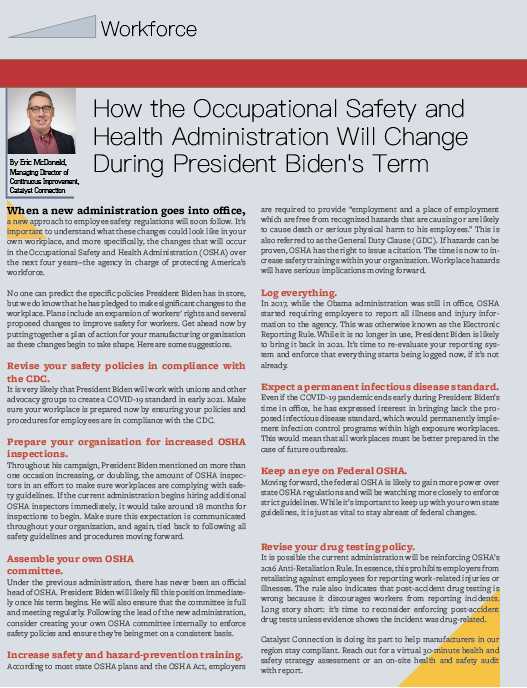How the Occupational Safety and Health Administration Will Change During President Biden's Term
By Eric McDonald, Catalyst Connection
 When a new administration goes into office, a new approach to employee safety regulations will soon follow. It’s important to understand what these changes could look like in your own workplace, and more specifically, the changes that will occur in the Occupational Safety and Health Administration (OSHA) over the next four years--the agency in charge of protecting America’s workforce.
When a new administration goes into office, a new approach to employee safety regulations will soon follow. It’s important to understand what these changes could look like in your own workplace, and more specifically, the changes that will occur in the Occupational Safety and Health Administration (OSHA) over the next four years--the agency in charge of protecting America’s workforce.
No one can predict the specific policies President Biden has in store, but we do know that he has pledged to make significant changes to the workplace. Plans include an expansion of workers' rights and several proposed changes to improve safety for workers. Get ahead now by putting together a plan of action for your manufacturing organization as these changes begin to take shape. Here are some suggestions.
Revise your safety policies in compliance with the CDC.
It is very likely that President Biden will work with unions and other advocacy groups to create a COVID-19 standard in early 2021. Make sure your workplace is prepared now by ensuring your policies and procedures for employees are in compliance with the CDC.
Prepare your organization for increased OSHA inspections.
Throughout his campaign, President Biden mentioned on more than one occasion increasing, or doubling, the amount of OSHA inspectors in an effort to make sure workplaces are complying with safety guidelines. If the current administration begins hiring additional OSHA inspectors immediately, it would take around 18 months for inspections to begin. Make sure this expectation is communicated throughout your organization, and again, tied back to following all safety guidelines and procedures moving forward.
Assemble your own OSHA committee.
Under the previous administration, there has never been an official head of OSHA. President Biden will likely fill this position immediately once his term begins. He will also ensure that the committee is full and meeting regularly. Following the lead of the new administration, consider creating your own OSHA committee internally to enforce safety policies and ensure they’re being met on a consistent basis.
Increase safety and hazard-prevention training.
According to most state OSHA plans and the OSHA Act, employers are required to provide “employment and a place of employment which are free from recognized hazards that are causing or are likely to cause death or serious physical harm to his employees.” This is also referred to as the General Duty Clause (GDC). If hazards can be proven, OSHA has the right to issue a citation. The time is now to increase safety trainings within your organization. Workplace hazards will have serious implications moving forward.
Log everything.
In 2017, while the Obama administration was still in office, OSHA started requiring employers to report all illness and injury information to the agency. This was otherwise known as the Electronic Reporting Rule. While it is no longer in use, President Biden is likely to bring it back in 2021. It’s time to re-evaluate your reporting system and enforce that everything starts being logged now, if it’s not already.
Expect a permanent infectious disease standard.
Even if the COVID-19 pandemic ends early during President Biden’s time in office, he has expressed interest in bringing back the proposed infectious disease standard, which would permanently implement infection control programs within high exposure workplaces. This would mean that all workplaces must be better prepared in the case of future outbreaks.
Keep an eye on Federal OSHA.
Moving forward, the federal OSHA is likely to gain more power over state OSHA regulations and will be watching more closely to enforce strict guidelines. While it’s important to keep up with your own state guidelines, it is just as vital to stay abreast of federal changes.
Revise your drug testing policy.
It is possible the current administration will be reinforcing OSHA’s 2016 Anti-Retaliation Rule. In essence, this prohibits employers from retaliating against employees for reporting work-related injuries or illnesses. The rule also indicates that post-accident drug testing is wrong because it discourages workers from reporting incidents. Long story short: it’s time to reconsider enforcing post-accident drug tests unless evidence shows the incident was drug-related.
Catalyst Connection is doing its part to help manufacturers in our region stay compliant. Reach out for a virtual 30-minute health and safety strategy assessment or an on-site health and safety audit with report.
Read the entire issue: